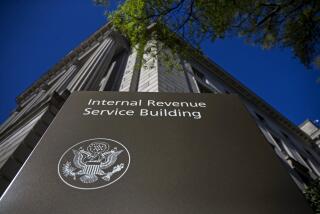Corporations Struggle With New Tax Rules : Coming to Grips With Code’s Complex Changes Will Cost Companies Extra Time and Money
- Share via
WASHINGTON — The next 10 days or so will not be a happy time for the tax managers of many of America’s major corporations, who are preparing to make their first tax payment under the tax code Congress rewrote last year.
Indications are that the effort will cost them a lot of sleep and their companies a lot of money.
“Some of us are having a lot of bleary-eyed long nights,” said Paul Freischlag, assistant treasurer for Stop & Shop Cos. Inc. and tax-committee chairman of the Tax Executives Institute. “We’re averaging a lot of hours”--despite the fact, Freischlag said, that his company faces a less complex tax situation than many other firms.
Unlike most individual taxpayers, who have income taxes withheld from their paychecks, corporations pay taxes four times a year. They estimate what they owe for the quarter, then reconcile the payments with their actual tax bills when they file their tax returns once a year.
Because the Tax Reform Act of 1986 made so many complex changes in deductions used by corporations, the Internal Revenue Service last March granted businesses a waiver that allowed them to make estimated payments based on the old tax code.
‘Shot in the Dark’
The waiver, which in effect allowed corporations to set their taxable income at last year’s amount plus 20%--to reflect the law’s tax increase on corporations--expired July 1. A minority of corporations already have made a payment under the new system, but for most, the first quarterly payment under the new law comes due on Sept. 15.
“For a lot of major corporations, meeting that Sept. 15 deadline is going to be something of a shot in the dark,” said Peggy Duxbury, director of taxation for the National Assn. of Manufacturers. Tax managers “are going to talk to their departments and say, ‘give me your best guess,’ and then cross their fingers and hope.”
The Internal Revenue Service has issued temporary or proposed regulations explaining some of the law’s corporate provisions, including a stiff new minimum tax, new methods for taxing inventories and changes in use of the foreign tax credit and other tax laws governing multinational corporations. But the regulations, some still subject to change, leave many questions unanswered, corporate tax directors say.
For instance, a provision of the minimum tax requires companies to calculate taxes on half of the difference between their profits as reported to shareholders and their taxable income. (Accounting rules allow companies to report higher earnings to shareholders than to Uncle Sam.)
Overpayments Predicted
But the time periods used for reporting financial profits often are different from the time periods over which large corporations calculate their estimated tax payments, leaving executives groping for figures to plug into their calculations.
Rumors are circulating that the IRS will extend the waiver through to the rest of the year, something that such organizations as the National Assn. of Manufacturers and the Tax Executives Institute have asked it to do. But Sept. 15 is fast approaching. And even if the IRS does grant an additional waiver, corporations still will have to figure their taxes for all of 1987 based on the complex new law when they do their returns next year.
“Our return for 1985 ran 4,800 pages, our return for 1986 will be over 5,000 pages and we don’t even have the complexity of the 1986 act in there,” said Dow Chemical tax director Glenn W. White. “I think our 1987 return could be up around 6,500 pages.”
Partly because they cannot yet master all that complexity, many corporate tax directors and accountants predict that companies will vastly overpay their estimated taxes in the Sept. 15 payment. The penalties for not paying enough under the new law are stiff--interest and penalties, which are not tax-deductible, on the amount underpaid for the year to date. And companies have to come within 90% of what they owe, rather than 80% as under the old tax system.
“I was talking to my staff about this and we came to the conclusion that 1987 is going to be the year of the ‘cushion,’ ” said Michael L. Borsuk, managing partner of the Long Island office of Coopers & Lybrand, the accounting firm.
Borsuk guessed that no more than 15% of his corporate clients, which are both large and small businesses, are trying to calculate a precise estimated tax figure using the details of the law. Most, he said, want to get the figures right but can’t pay for the long accounting hours it would take to do more than a good guess.
In many cases, Borsuk said, the expense of hiring tax accountants or paying an accounting firm is higher than the penalties that a company might incur by underpaying its estimated taxes. And even companies that can afford the accounting expertise may not be able to make all the decisions that the new law requires about such issues as how to account for inventory in time for the deadline.
Difficult to Police
Corporate tax directors, still reeling from changes in the tax laws enacted in 1981, 1982 and 1984, say they fear the additional complexity of the 1986 act’s corporate provisions might encourage a proliferation of corporate tax avoidance--something the IRS might find it difficult to police under the new code.
“There used to be a time when we knew what the rules were and could do what the government wanted,” said Freischlag of Stop & Shop. “The cumulative effect of all those changes is wearing us out.”
More to Read
Inside the business of entertainment
The Wide Shot brings you news, analysis and insights on everything from streaming wars to production — and what it all means for the future.
You may occasionally receive promotional content from the Los Angeles Times.










